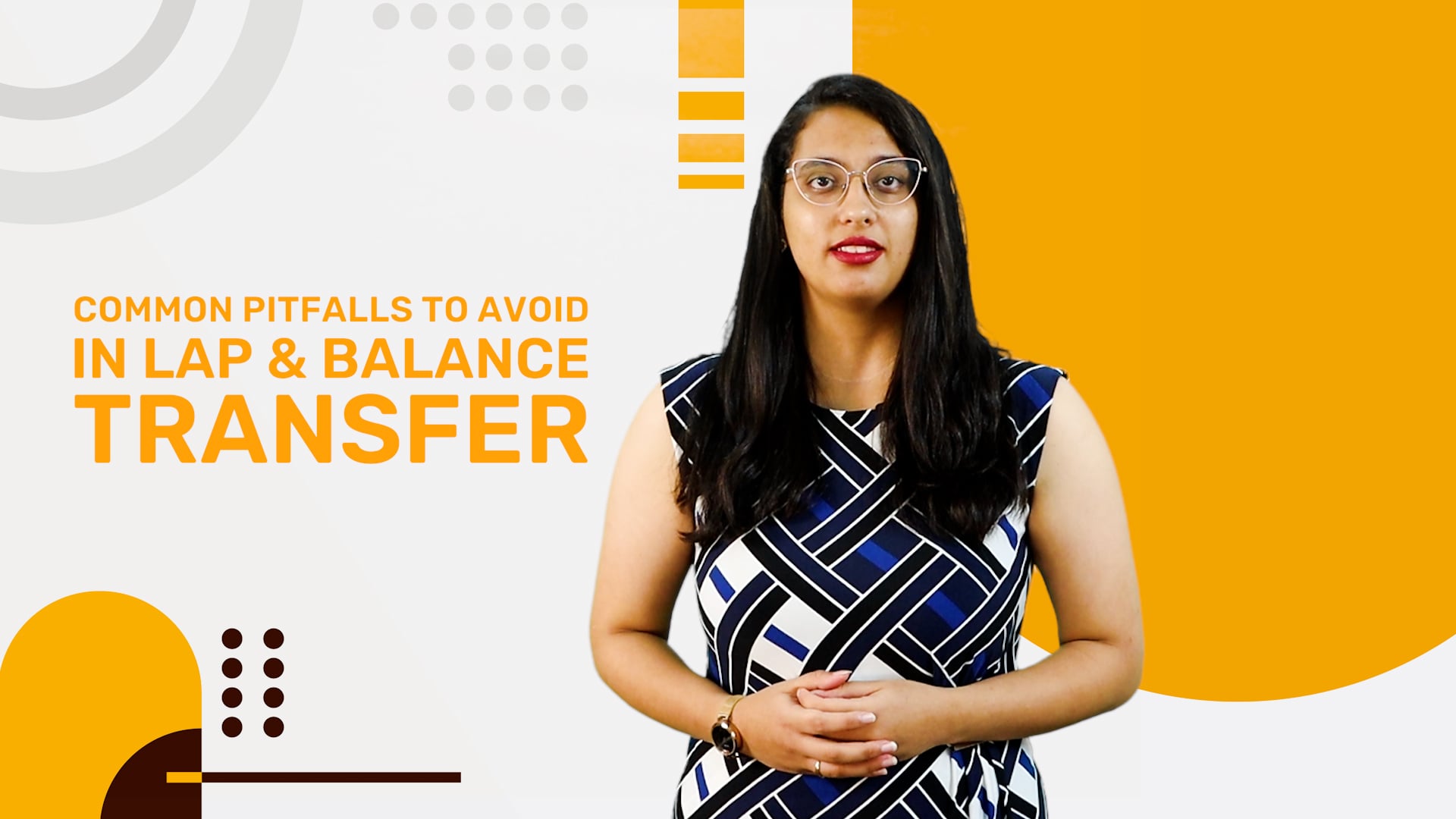Loan Against Property & Its Balance Transfer
Episodes

E01: Understanding Loan Against Property
03 mins
In this video, we’ll explore the essentials of a Loan Against Property (LAP). This is a secured loan option that permits you to leverage your property as collateral to obtain funds. This financing tool can be used for needs like business expansion, education costs, or emergencies. To start, we’ll see how LAP works by assessing both the market value of your property and your ability to repay. This valuation and your creditworthiness determine the loan amount a lender will approve. You’ll also learn that any default in repayment could give the lender the right to repossess and sell the property. This is because the loan is secured against property. Next, the video will cover what types of properties can be used as collateral for LAP. Remember that each lender may have specific requirements based on location and condition. You’ll also find out that the interest rates for LAP are generally lower than unsecured loans. However, it’s crucial to carefully evaluate the loan terms, as your property is the collateral. In short, LAP could be a beneficial option for property owners needing significant funds. What you need is a solid repayment plan. Stay tuned to Academy for more financial insights into loans against property.

E02: Types of Properties Accepted for LAP
02 mins
Welcome to another insightful video on Loan Against Property (LAP), a popular choice for financing personal and business needs! Today, let's break down the types of properties you can use as collateral for such loans in India. First up, we’ll look at Residential Properties like homes, apartments, and plots designated for residential use. These could be ideal for LAP due to their stable value and demand. You can use them to secure funds for goals such as education, business growth, and more. Next, you’ll get to explore Commercial Properties such as office spaces, retail stores, and warehouses. These are valued based on factors like location, rental income, and growth potential. If you own a commercial property, it could serve as collateral to finance business needs, equipment purchases, etc. Lastly, the video will take you through Industrial Properties—including manufacturing units and warehouses. These are valued based on functionality, infrastructure, and location advantages. They can help secure a LAP for expanding operations, investing in technology, and so on. No matter the type, leveraging your property through LAP could offer you with a flexible way to access funds. So, explore your options carefully to see how you can unlock the potential of your assets!

E03: Loan Amount and EMI Calculation in LAP
02 mins
Considering a Loan Against Property (LAP) but stumped about the numbers and math involved? No worries! Let's break down how lenders decide the loan amount in this video. First, we’ll understand how lenders assess the current market value of the property being used as collateral. Then, you’ll find out how they evaluate your eligibility based on factors like income, credit history, age, and existing liabilities. All these influence your Loan-to-Value (LTV) ratio. We’ll also discuss how the LTV ratio usually ranges from 50% to 75% of the property’s value. For example, if your property is worth ₹1 Crore and the LTV is 60%, you might be eligible for a loan of up to ₹60 Lakhs. Next, the video will dive into the EMI calculation. The formula for calculating LAP EMIs is: EMI = [P x r x (1+r)^n] / [(1+r)^n - 1], where P is the loan amount, r is the monthly interest rate, and n is the loan tenure in months. For instance, a ₹30 Lakh LAP over 14 years at 10% interest results in an EMI around ₹33,246. Remember, timely EMI payments are essential for maintaining good credit and a smooth repayment journey. As always, stay tuned to Academy for more simplified financial insights.

E04: Insurance in LAP
02 mins
The necessity of insurance in Loan Against Property (LAP) cannot be overstated. So, in this video, let’s try to break down why insurance can be crucial when opting for a Loan Against Property (LAP). First, we’ll explore how property insurance can play a significant role in the context of LAP. In India, where natural disasters like floods and earthquakes are common, property insurance can be very beneficial. You will also see how this could provide financial protection for your pledged property against any damage. This means safeguarding your asset as well as ensuring that your loan remains secure. Next, the video will discuss how life insurance can fit with a Loan Against Property. Life’s unpredictability makes life insurance a vital part of LAP. In case of someone’s unfortunate demise, life insurance could help cover the outstanding loan. Hence, you will understand how this pay-out could ensure that your family doesn’t inherit your loan. In short, we’ll break down how insurance in LAP is more than an added expense—it can be a strategic safeguard. Property insurance protects against unforeseen damage, and life insurance ensures your family doesn’t shoulder loan obligations. Together, they could provide a secure borrowing experience and a protected investment for the lender.

E05: Benefits of LAP Balance Transfer
03 mins
In today’s fast-paced world, managing your finances smartly is essential. This video will elaborate on how a Loan Against Property Balance Transfer can be a great way to achieve this. First, we’ll try to define A LAP Balance Transfer or LAPBT. It involves moving your existing loan against property to a different lender offering more favourable terms Next, you’ll learn about these key benefits. The main attraction of LAP balance transfer is often a lower interest rate. Besides interest savings, we’ll also explore the improved terms that a lender might offer. These include flexible repayment schedules, longer tenures, or options to switch between fixed and floating rates. Reduced interest and better loan terms can bring down your total loan cost. You’ll gradually understand how this could free up your funds for other purposes. The video will also dive into how consolidating multiple debts into a single LAP balance transfer might simplify tracking and managing payments. Finally, we’ll explain how a balance transfer could boost your credit score with timely payments. In essence, a LAP Balance Transfer could offer significant advantages, like interest savings, improved financial management, and credit score enhancement. If you’re aiming to streamline your finances, it could be worth exploring this financial option.

E06: Common Pitfalls to Avoid in LAP and Balance Transfer
03 mins
In today’s financial landscape, Loans Against Property (LAP) and Balance Transfers can be popular ways to manage expenses and consolidate debt. However, they could come with common pitfalls that might lead to financial strain. Let’s go through these pitfalls in this video and learn how to avoid them. First, we’ll discuss the importance of thorough research. Not comparing multiple lenders could result in unfavourable terms, higher interest rates, or hidden fees. You'll see why it could be helpful to explore different lenders and understanding their terms. Overall, this practice could be a financially sound decision. Next, you’ll understand the significance of factoring in all costs. Be aware of all associated expenses like processing fees and legal charges, which can quickly add up. We'll see how a clear understanding of these costs could help you budget effectively. Finally, the video explores the possible risk of signing agreements without fully grasping the terms. Ignoring fine print could lead to unexpected fees or restrictive clauses. So, take the time to read all terms carefully and ask questions when needed. In summary, navigating LAP and Balance Transfers wisely requires research, awareness of costs, and a solid grasp of terms. Steer clear of these common pitfalls and stay financially fit.

E07: Tax Implications of Loan Against Property
03 mins
A Loan Against Property (LAP) can be a practical way to access funds during emergencies, but did you know it can also help reduce your tax burden? This video will explore these tax implications. First, we’ll discuss tax savings under the Old Tax Regime. Under Section 24(b) of the Income Tax Act, salaried individuals can claim tax deductions on the interest paid for LAP. The funds should be used for construction, repair, or renovation of a residential property. This allows up to ₹2 Lakhs deduction per year. Next, you’ll understand Section 37(1), which provides deductions for the interest on LAP if used specifically for business expenses. However, these deductions only apply to the interest portion. We’ll also talk about tax deductions on the principal repayment. This goes up to ₹1.5 Lakhs per year, under Section 80C. Finally, the video will explore how transferring your LAP to a new lender for a lower interest rate can also impact your tax savings. However, the total deduction cannot exceed ₹2 Lakhs annually across all lenders. Ultimately, the tax benefits applicable on a LAP depend on how you use the funds. Remember to use these provisions wisely to make your loan a tax-saving ally!

E08: Government Policies and Regulations for LAP
03 mins
Good day, everyone! Thinking of taking a Loan Against Property (LAP)? Let’s go over the government policies and regulations surrounding LAP in this video to help you make an informed choice. First, we’ll discuss how the Reserve Bank of India (RBI) plays a central role in setting guidelines for LAP. The RBI regulates benchmark rates, like the repo rate, which lenders use to determine their own interest rates. Next, you'll understand the Loan-to-Value (LTV) ratio set by the RBI. These dictate the maximum loan you can get based on your property’s value. Currently, LTV caps are set at 90% for loans up to ₹30 Lakhs, 80% for ₹30-75 Lakhs, and 75% for loans above ₹75 Lakhs. Then, the video explores RBI-defined eligibility criteria like minimum income, a good credit score, and property type, ensuring only qualified applicants receive LAPs. Additionally, your repayment tenure must not exceed the property’s remaining lease, supporting responsible borrowing. Lastly, we’ll go over some government initiatives like RERA and the Insolvency and Bankruptcy Code (IBC). These bring more transparency to real estate and help manage non-performing assets, thus indirectly impacting your loan. Remember, knowing these regulations and comparing lenders carefully could empower you to choose a suitable Loan Against Property.
What to Watch Next
All

























